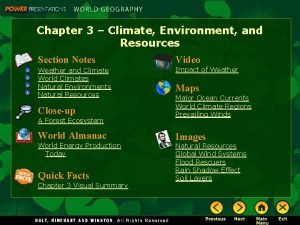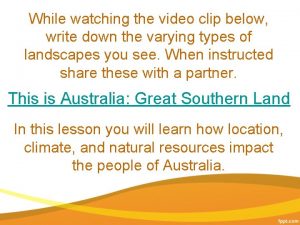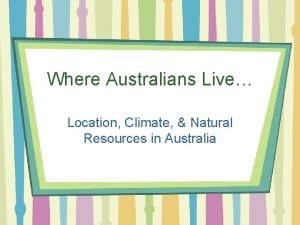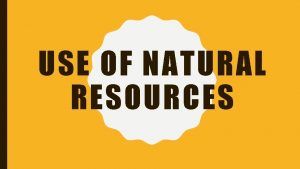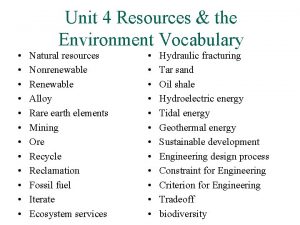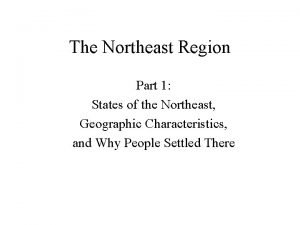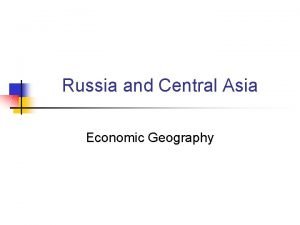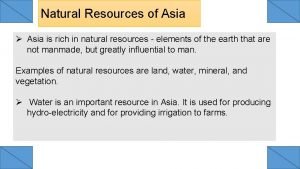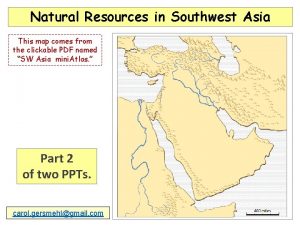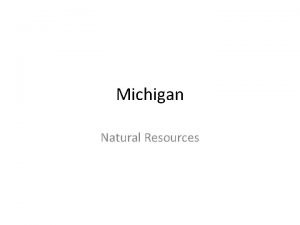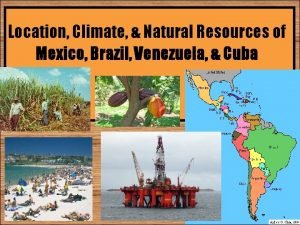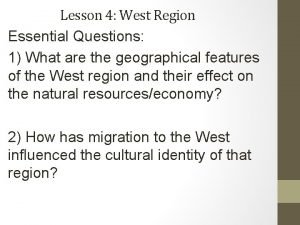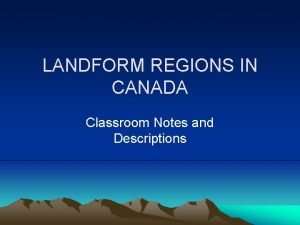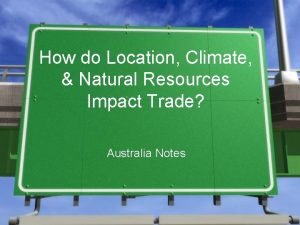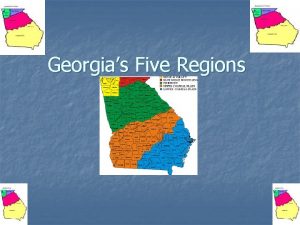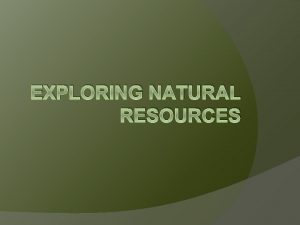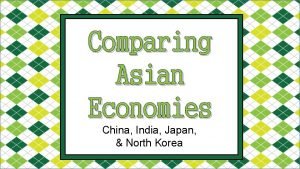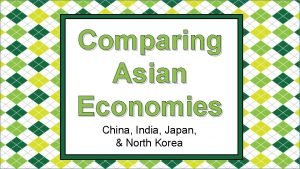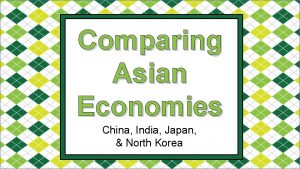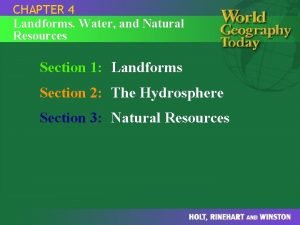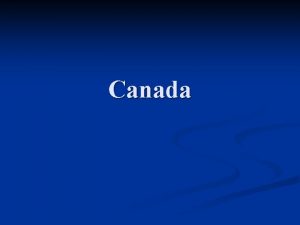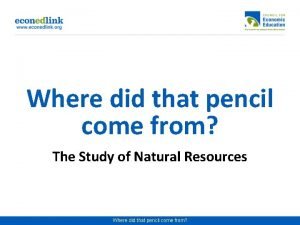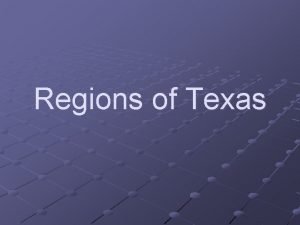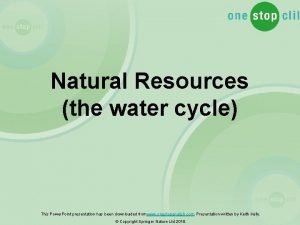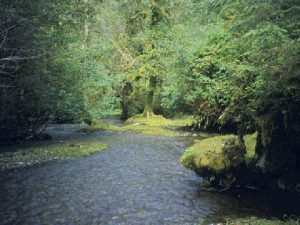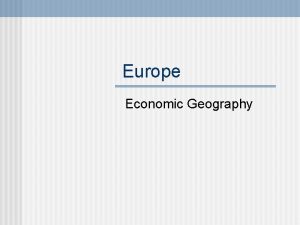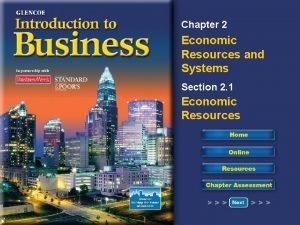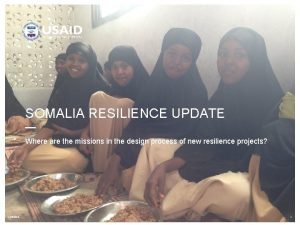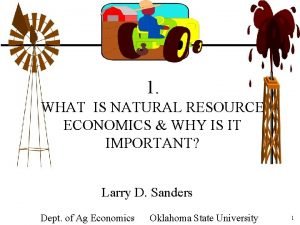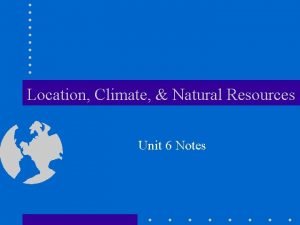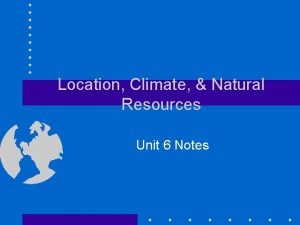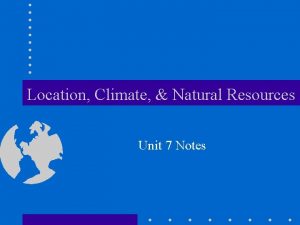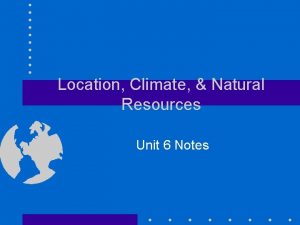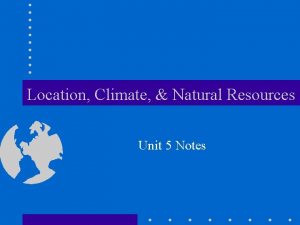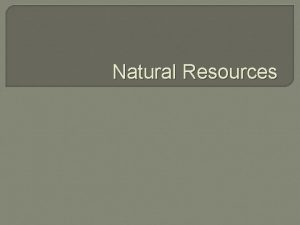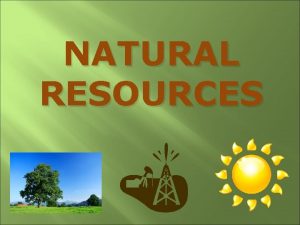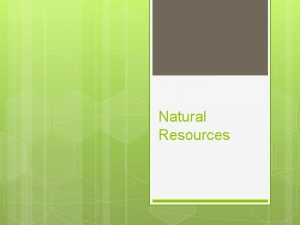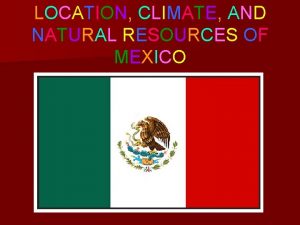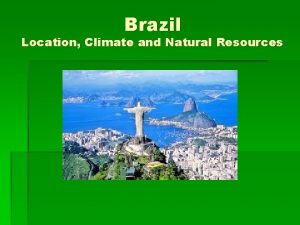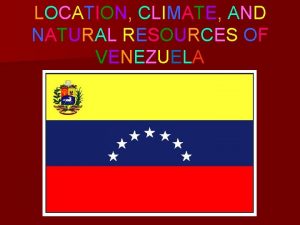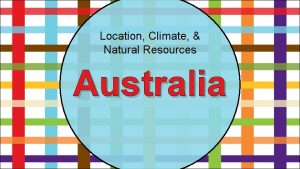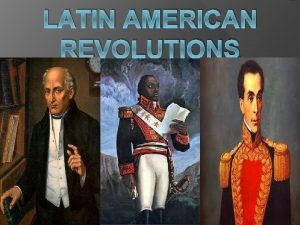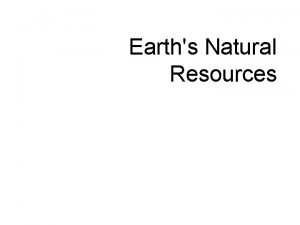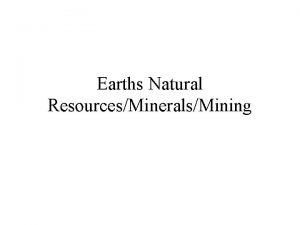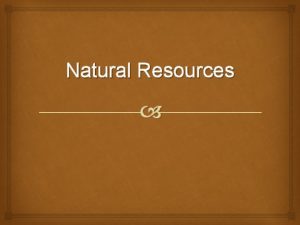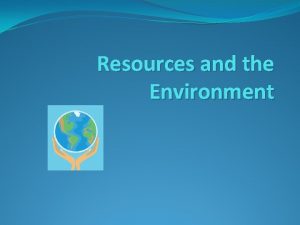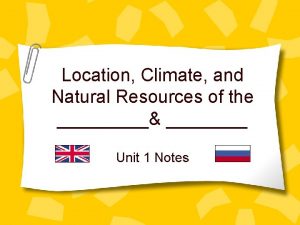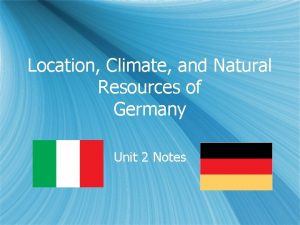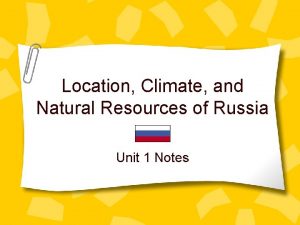Location Climate Natural Resources Unit 6 Notes Latin





































- Slides: 37

Location, Climate, & Natural Resources Unit 6 Notes

Latin America • How do location, climate, and natural resources affect where people live and how they trade in Latin America? • Let’s take a closer look at Mexico, Venezuela, Brazil, & Cuba…

Mexico’s Location • south of the US, east of the Pacific Ocean, and west of the Gulf of Mexico & Caribbean Sea • located between major bodies of water: – great opportunities for trading – can easily ship goods around the world • another advantage: close to US, so trade between two countries is convenient


Mexico’s Climate • Climate varies according to location but tends to be dry and warm

Mexico’s Natural Resources • Oil is one of the top exports: – exports 1. 7 million barrels/day – Money from oil sales provides 1/3 of government’s budget. • It is one of the world’s top producers of silver. • Other resources include natural gas, copper, gold, lead, zinc, and timber (choose any 3) • 12% arable land

Physical Characteristics • Very mountainous with large central plateau • Tropical beaches • Dry deserts

Where People Live in Mexico • Most people live in central Mexico: – Nearly 20% of the people live in the area of Mexico City – 2 nd most populous country in Latin America – Largest Spanish-speaking country in the world • urban: 77% • rural: 23%

Trade in Mexico • mix of new and old industries – recently expanded railroads, airports, and electric generating plants • 7 major seaports • exports: oil, manufactured goods, silver, fruits, vegetables, coffee, & cotton • tourism

Venezuela’s Location • in northeast part of South America; just north of equator • coasts on Caribbean Sea and Atlantic Ocean – gives it easy access to trade with other countries – nearby Panama Canal provides a shortcut to the Pacific to trade with Asian countries • mountains in the north and south, only about 3% arable land


Venezuela’s Climate • hot, tropical climate • cooler in the mountains • rain varies by region (16 inches on the coast; over 100 inches in the mountains)

Venezuela’s Natural Resources • Oil • Natural gas, iron ore, gold, bauxite, other minerals, hydropower, diamonds (choose any 3) • 3% arable land – mostly better for pastures than crops


Physical Characteristics • Mountain systems break Venezuela into four distinct areas: • (1) the Maracaibo lowlands • (2) the mountainous region in the north and northwest • (3) the Orinoco basin, with the llanos (vast grasscovered plains) on its northern border and great forest areas in the south and southeast • (4) the Guiana Highlands, south of the Orinoco, accounting for nearly half the national territory. •


Where People Live in Venezuela • urban: 88% • rural: 12% • Caracas is the largest city • Most people live in the northern highlands, along the coast.

Trade in Venezuela • sixth-largest oil exporter in the world – produces 2. 8 million barrels/day – 90% of the money the government makes on trade comes from oil exports • 4 major seaports • other exports: bauxite and aluminum, steel, chemicals, agricultural products, basic manufactures • tourism • Farming provides jobs for 10% of the population.

Problems in Mexico & Venezuela • millions of citizens live in poor conditions – little or no health care, poor education • both countries rely on oil production for a large part of their trade: – When price of oil goes down, it is difficult for the government to pay its bills and help its people. – Pollution caused by oil is also a problem.

Brazil’s Location • eastern side of South America, along the coast of the Atlantic Ocean • shares a border with nearly every country in South America! • Amazon River and other large rivers stretch across Brazil • The equator crosses the northern part of the country • Largest country in Latin America

Brazil’s Climate • Location on the equator gives it the climate needed to support one of the world’s largest rainforests. • Climate is mostly hot and tropical. • In the south, the climate is temperate (mild).

Brazil’s Natural Resources • Only 7% of land is arable, but Brazil makes the most of this resource – Farmers grow 1/3 rd of the world’s coffee, and lead the world in production of oranges, papayas, sugar cane, and soybeans • Only the US exports more farm products that Brazil • Other resources include bauxite, gold, iron ore, manganese, nickel, phosphates, platinum, tin, uranium, oil, hydropower, and timber (choose any 3)


Physical Characteristics • The Amazon rain forest in the north and lowlying mountains and hilly terrain to the south flanks the country.

Where People Live in Brazil • • urban: 84% rural: 16% most populated country in Latin America largest Portuguese-speaking country in the world • most Brazilians live along the coasts; 80% live within 200 miles of the ocean • Nearly all cities and large towns are in the coastal area

Brazil’s Trade • 7 major seaports • exports: transportation equipment, iron ore, soybeans, footwear, coffee, autos, sugar, fruits • tourism – Amazon Rainforest attracts many visitors – beaches are another attraction • USA is Brazil’s largest trading partner

Cuba’s Location • an island 90 miles south of Florida, in the Caribbean Sea • 700 miles long • largest island in the West Indies • location on ocean trading routes has been an important influence on its history and economy

Cuba’s Climate • tropical but moderated by trade winds – It’s warm to hot all year long, but the winds provide relief from the heat • rainy season from May to October and a dry season from November to April • target for hurricanes – Hurricane season runs from June to November.

Cuba’s Natural Resources • 28% of Cuba’s land is arable • Other resources include cobalt, nickel, iron ore, chromium, copper, salt, timber, silica, petroleum (choose any 3)



Physical Characteristics • flat to rolling plains and hilly to rugged mountain areas in its southeast. • The highest point in Cuba is Pico Turquino at 6, 578 feet (2, 005 m).

Where People Live in Cuba • urban: 76% • rural: 24% • Havana is the largest city – 20% of Cubans live in Havana

Cuba’s Trade • 3 major seaports • exports: sugar, nickel, tobacco, fish, medical products, citrus, coffee • tourism • Venezuela is Cuba’s largest trading partner; it sells oil to Cuba at a reduced price.

Latin American Mascots! • Create a mascot to represent one of the following countries: Cuba, Mexico, Brazil, and Venezuela. 1. Create an illustration of your country’s mascot. 2. Write at least 3 reasons why the mascot represents your country.

Juan the Taco! 1. Most people live in the center of Mexico; most of the filling of the taco is in the center. 2. The yellow shell of the taco represents the sun in Mexico. 3. Help me think of another!

Credits • Original presentation retrieved from www. Slide. Share. net on February 5, 2012 • Read more: Venezuela: Maps, History, Geography, Government, Culture, Facts, Guide & Travel/Holidays/Cities — Infoplease. com http: //www. infoplease. com/ipa/A 0108140. html#ixzz 1 m 29 uk 0 IH • http: //www. mapsofworld. com/country-profile/brazil. html • http: //geography. about. com/od/cubamaps/a/cubageography. htm • www. google. com/images • Georgia CRCT Test Prep 6 th Grade Social Studies. Clairmont Press, Inc. Lilburn, GA. 2009.
 Climate change 2014 mitigation of climate change
Climate change 2014 mitigation of climate change Warm climate
Warm climate Natural vegetation
Natural vegetation Latin america climate zones
Latin america climate zones What is transforming resources
What is transforming resources Variable resources definition
Variable resources definition Renewable resources vs nonrenewable resources
Renewable resources vs nonrenewable resources A cross country skier moves from location a
A cross country skier moves from location a Location planning in operations management
Location planning in operations management Australia major natural resources
Australia major natural resources Climate of australia
Climate of australia What are the 4 types of natural resources
What are the 4 types of natural resources Natural resources vocabulary
Natural resources vocabulary Resources of the northeast region
Resources of the northeast region Russia resources
Russia resources Malaysia rich in natural resources
Malaysia rich in natural resources Southwest asia natural resources
Southwest asia natural resources Natural resources found in michigan
Natural resources found in michigan Brazil main resources
Brazil main resources West region products
West region products Landforms in canada
Landforms in canada Australia natural resources
Australia natural resources Blue ridge region
Blue ridge region Explain natural resources
Explain natural resources Japan major natural resources
Japan major natural resources Japan natural resources
Japan natural resources Japan natural resources
Japan natural resources Natural resources from landforms
Natural resources from landforms Natural resources in the canadian shield
Natural resources in the canadian shield Plant assets are
Plant assets are Where did pencil come from
Where did pencil come from Balcones escarpment
Balcones escarpment Natural resources water cycle
Natural resources water cycle Inexhaustible natural resources
Inexhaustible natural resources Natural resources of northern europe
Natural resources of northern europe Some natural resources, such as wheat and cattle, are
Some natural resources, such as wheat and cattle, are Somalia natural resources
Somalia natural resources Non storable resources
Non storable resources

